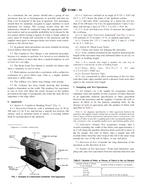Potrebujeme váš súhlas na využitie jednotlivých dát, aby sa vám okrem iného mohli ukazovať informácie týkajúce sa vašich záujmov. Súhlas udelíte kliknutím na tlačidlo „OK“.
ASTM D1388-14
Standard Test Method for Stiffness of Fabrics
Automaticky preložený názov:
Štandardná skúšobná metóda pre tuhosti tkaniny
NORMA vydaná dňa 1.7.2014
Informácie o norme:
Označenie normy: ASTM D1388-14
Poznámka: NEPLATNÁ
Dátum vydania normy: 1.7.2014
Kód tovaru: NS-17139
Počet strán: 6
Približná hmotnosť: 18 g (0.04 libier)
Krajina: Americká technická norma
Kategória: Technické normy ASTM
Anotácia textu normy ASTM D1388-14 :
Keywords:
bending length, fabric, fabric, flexural rigidity, stiffness, ICS Number Code 59.080.30 (Textile fabrics)
Doplňujúce informácie
| Significance and Use | ||||||||||||
|
5.1 Both test options in this test method are considered satisfactory for acceptance testing of commercial shipments since current estimates of between-laboratory precision are acceptable and the method is used extensively in the trade for acceptance testing. 5.1.1 In case of a dispute arising from differences in reported test results when using this test method for acceptance testing of commercial shipments, the purchaser and the supplier should conduct comparative tests to determine if there is a statistical bias between their laboratories. Competent statistical assistance is recommended for the investigation of bias. As a minimum, the two parties should take a group of test specimens that are as homogeneous as possible and that are from a lot of material of the type in question. Test specimens should then be randomly assigned in equal numbers to each laboratory for testing. The average results from the two laboratories should be compared using the appropriate statistical analysis and an acceptable probability level chosen by the two parties before testing is begun. If a bias is found, either its cause must be found and corrected or the purchaser and the supplier must agree to interpret future test results with consideration to the known bias. 5.2 In general, these procedures are more suitable for testing woven fabrics than knit fabrics. 5.3 The Cantilever Test Option is the preferred procedure because it is simpler to perform. It is, however, not suitable for very limp fabrics or those that show a marked tendency to curl or twist at a cut edge. 5.4 The Heart Loop Test Option is suitable for fabrics that show a tendency to curl or twist. 5.5 Both options can provide a correlation with a subjective evaluation of a given fabric type. That is, a higher number represents a stiffer fabric. 5.6 The stiffness of a fabric may change with storage. 5.7 No evidence has been found showing that bending length is dependent on the width. The tendency for specimens to curl or twist will affect the result, because of the rigidity provided at the edge. Consequently, the wider the strip, the less important is the edge effect. |
||||||||||||
| 1. Scope | ||||||||||||
|
1.1 This test method covers the measurement of stiffness properties of fabrics. Bending length is measured and flexural rigidity is calculated. Two procedures are provided. 1.1.1 Option A—Cantilever Test, employing the principle of cantilever bending of the fabric under its own mass. 1.1.2 Option B—Heart Loop Test, employing the principle of a loop formed in a fabric strip and hung vertically. 1.2 This test method applies to most fabrics including woven fabrics, air bag fabrics, blankets, napped fabrics, knitted fabrics, layered fabrics, pile fabrics. The fabrics may be untreated, heavily sized, coated, resin-treated, or otherwise treated. 1.3 The values stated in SI units are to be regarded as the standard. The U.S. customary units may be approximate. 1.4 This standard does not purport to address all of the safety concerns, if any, associated with its use. It is the responsibility of the user of this standard to establish appropriate safety and health practices and determine the applicability of regulatory limitations prior to use. |
||||||||||||
| 2. Referenced Documents | ||||||||||||
|
Odporúčame:
Aktualizácia technických noriem
Chcete mať istotu, že používate len platné technické normy?
Ponúkame Vám riešenie, ktoré Vám zaistí mesačný prehľad o aktuálnosti noriem, ktoré používate.
Chcete vedieť viac informácií ? Pozrite sa na túto stránku.




 Cookies
Cookies
